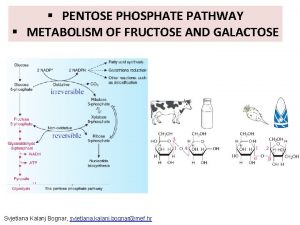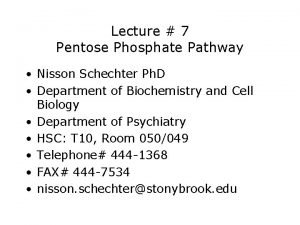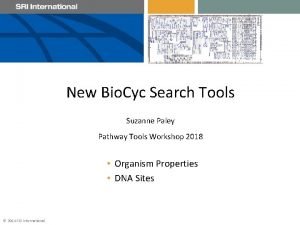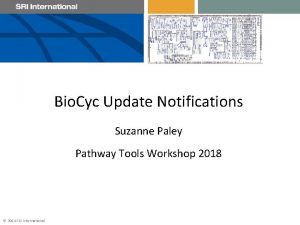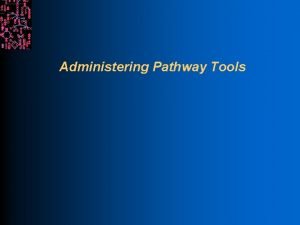The Regulation Summary Diagram Suzanne Paley Pathway Tools








- Slides: 8

The Regulation Summary Diagram Suzanne Paley Pathway Tools Workshop 2010 1 SRI International Bioinformatics

How can Protein Levels and Function be Regulated? l Transcription Initiation – transcription factors l Transcription Initiation – sigma factors l Attenuation (various kinds) l Translation (various kinds) l Post-translational modification l Complex formation l Cofactors l Substrate-level modulation l Degradation 2 SRI International Bioinformatics

Motivations and Design Factors l Combine all forms of regulation into a single unified diagram l Diagram should be intuitive to a biologist l Several biologists involved in design process l Diagram is automatically generated from the data – no manual tweaking! l Diagram should be compact, mostly horizontal l OK to omit low-level details 3 SRI International Bioinformatics

Example: trp. D Organized around biology’s central dogma: DNA > RNA -> protein • Green indicates activation, magenta indicates inhibition (both defined loosely) • Things to notice: • Transcription factor with ligand • Sigma factor • Operon organization • Attenuation leads to truncated m. RNA • Substrate-level regulation of complex • 4 SRI International Bioinformatics

Example: opp. D Things to notice: • Ligands can either activate or inhibit transcription factors • Translational regulation Riboswitch • Small RNA, with accessory protein • • Multiple 5 complexes SRI International Bioinformatics

Example: bgl. G Things to notice: • Transcription factors grouped: activators, inhibitors • Positive attenuation points to full-length m. RNA • Post-translational phosphorylation 6 SRI International Bioinformatics

More Examples: gln. G, spe. D Things to notice: • Multiple sigma factors • Dual transcription factors • Regulation of post-translational modification • Post-translational cleavage and complexation 7 SRI International Bioinformatics

Where Does Diagram Appear? l Gene/Gene product pages l Not in eukaryotic or multi-organism PGDBs l Is diagram useful when no regulation? l Regulation information must be curated, not inferred by Patho. Logic l In PGDBs with no curated regulation information, diagram does not appear for any gene l Otherwise, it appears for every gene l PGDBs with regulatory information: l Eco. Cyc l Bsub. Cyc 8 SRI International Bioinformatics

